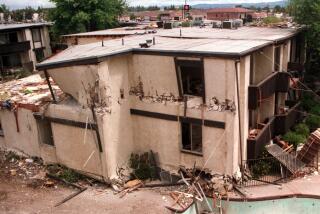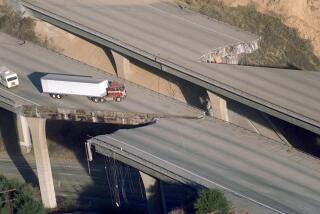Ordeal Put the Pedal to Family’s Mettle : Bob’s breathing became so difficult that Judy hooked up the device to an oxygen tank. For close to an hour, Chris used the “ambu bag” to keep his father alive.
- Share via
“This time,” Judy Horn said, “our dogs alerted us.”
Holly, usually a picture of calm, grew nervous. After the 3.8 aftershock hit early Saturday morning, the black Lab forced her way into Judy’s room. Soon Judy was up feeding biscuits to Holly, Rex and the chronically skittish Butch.
Then Judy decided to check on her ailing husband. She was at Bob’s side when the 5.0 aftershock hit at 3:20 a.m., centered just a few miles north of their Winnetka home.
With one hand, Judy held on to Bob. With the other, she held on to his mechanical lung.
*
It’s been two weeks and a day since the 6.6 haymaker sent us reeling. True, we don’t know when the aftershocks will end. But as I took my own secret shortcut to work Monday, it was good to see that some of the fallen block walls were being rebuilt. Slowly, life seems to be returning to normal.
This also seems true for the Horn family--and normal for them is extraordinary.
Readers may recall Bob and Judy Horn. Bob is a former Cal State Northridge political science professor who five years ago was stricken with amyotrophic lateral sclerosis (ALS). Now virtually paralyzed by the disease, Horn survives with the aid of a ventilator--a battery-powered box that feeds air to his windpipe through a plastic tube. Although his body has failed him, Prof. Horn still displays a sharp mind and an active wit with the help of a specially rigged computer or the coded movements of his eyebrows.
If the Jan. 17 quake was frightening for you, imagine what it was like for the immobile Bob Horn, whose mechanical lung was pitched to the floor and damaged. Imagine what it was like for Judy as she heard the ventilator alarm, signaling that Bob wasn’t getting any air.
“I don’t think I had time to go into the apprehension and fear,” Judy says, “because I had so much to do.”
Judy and Bob, fortunately, weren’t alone. Their 22-year-old son, Chris, was at home, as was a nursing attendant. So was Judy’s 77-year-old mother, Marion, who’d shuffled in from the cold of Buffalo, N. Y., for a visit, only to come down with the flu.
The others made it through the quake without harm. They focused their attention on Bob.
First they disconnected Bob’s broken “vent” and hooked up a device known as an “ambu bag”--a manually operated device that pumps air into his lungs.
This wasn’t the only concern. Earlier that week, Bob had developed a bronchial infection that required the suctioning of fluids from his throat. With the power knocked out by the earthquake, they resorted to a portable, battery-powered suction device that provided only minimal help.
Bob’s breathing became so difficult that Judy hooked up the device to an oxygen tank. For close to an hour, Chris used the “ambu bag” to keep his father alive. Judy dug through the books and memorabilia that had fallen in the den to retrieve Bob’s wheelchair, with the portable ventilator attached.
Chris tried to explain his father’s ordeal.
“He’s helpless all the time,” Chris said. “And when you run into something like an earthquake, when people who are not sick are helpless, it magnifies his helpless feeling.
“I was scared. My mom was scared. But that has to be shoved aside to make sure he gets through it. . . . It was amazing what my mom was able to do.”
Friends pitched in as well. A neighbor shut off the gas line. Mario Hernandez, a nursing assistant who has been with the Horns for three years, left his own damaged apartment in Reseda to check on the Horns. Chris’ friend Ben Turner also showed up. Together, Chris and Ben were able to lift Bob into his wheelchair and place him in the van for a trip to the hospital, Humana West Hills.
Judy Horn has nothing but praise for how the hospital’s doctors, nurses and attendants reacted to the crisis.
With Bob in the hospital, the Horns turned to chores at home. Broken pipes had flooded part of the house. A block wall was down in the back yard. Like so many people in the Valley, they were living without power, gas and water service. “We’re really, really lucky,” Chris said. “There are people a lot worse off than we are.”
Judy’s mother, who had always said she hoped to experience an earthquake on a California visit, headed home with a heck of a story to tell.
Last Friday, 11 days after the 6.6 quake hit, Bob came home from the hospital--just in time for a big aftershock.
Judy says they’ve learned a few lessons. Now Bob’s ventilator is strapped to the table by a bungee cord. And his portable ventilator is close at hand.
*
Judy Horn tends to focus on the silver linings. One of the nice things about the Northridge earthquake, she says, is that old friends from all over the world have checked in to see how they’re doing.
Sometimes, these calls have a certain poignancy. The other day, the Horns received a call from one of Bob’s old frat brothers. They’d been out of touch for such a long time that he wasn’t aware of Bob’s illness.
But this friend, and all the others, would be happy to know that Bob’s wit survived the quake just fine.
Talking with eyebrows, Bob says there is only one reason he went to the hospital.
“I couldn’t deal with the cleanup.”
Scott Harris’ column appears Tuesday, Thursday and Sunday. Readers may write Harris at The Times Valley Edition, 20000 Prairie St., Chatsworth, CA 91311.
More to Read
Sign up for Essential California
The most important California stories and recommendations in your inbox every morning.
You may occasionally receive promotional content from the Los Angeles Times.










